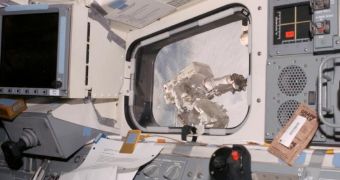Yesterday, the crew of STS-123 mission executed the scheduled spacewalk to test the new heat-shield repair technique developed by NASA. The Tile Repair Ablator Dispenser, or T-RAD, was designed to be used in the repair of damaged heat tiles covering the underbelly of the space shuttle. The need for a repair technique for the heat shield became obvious with the disintegration of the space shuttle Columbia, during a re-entry maneuver in 2003.
While launching into space, the left wing of the space shuttle Columbia was hit by a piece of insulating foam, roughly the size of a small briefcase and weighing about half a kilogram. The impact of the insulating piece of foam that came apart from the external fuel tank is thought to have created a gap about 30 centimeters in diameter, thus allowing access of hot streams of gas into the wing during re-entry. Eventually, the weakened structure of the wing gave in to stress and disintegrated, destroying the shuttle as well in the process.
During the spacewalk, astronomers Mike Foreman and Robert Behnken went outside the space station, to the worksite attached to the Destiny module, and squirted a pink substance of the damaged tiles to observe how the material would react in a weightless, vacuumed environment. "It goes down really well," said Foreman during the experiment.
According to NASA, the spacewalk began at 06:04 p.m. EDT and lasted 6 hours and 24 minutes. In the previous three missions, the crew of Endeavor attached the first component of JAXA's Kibo space laboratory and the Canadian robot Dextre.
Tile repair experiment
T-RAD is the first tile repair ever conducted in Earth's orbit. Although the repair technique works perfectly on Earth, the conditions are somehow different in space. ISS flight director Dana Wigel reports that the experiment went incredibly well and confirms the predictions that the T-RAD behaves in space exactly like it did back on Earth. The used ablator tiles resembled some of those on the tile gouge retrieved after the last mission of 2007 from Endeavor.
The forth spacewalk of STS-123 marked the 108th spacewalk in the build of the ISS. Bohnken and Foreman, who made their first spacewalks ever during STS-123, spent 13 hours and 17 minutes, respectively 13 hours and 32 minutes outside the space station, and are also expected to participate in the fifth spacewalk scheduled for Saturday.
The second objective of the spacewalk conducted yesterday was to repair a circuit breaker outside the space station, however astronauts reported that they had failed in their attempt due to a stuck connector. The thermal glove of one of Dextre's arms was also removed, albeit finding a lost pin in a berthing port has proved to be impossible.

 14 DAY TRIAL //
14 DAY TRIAL //